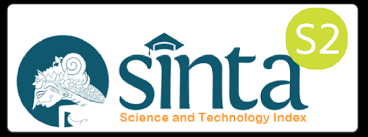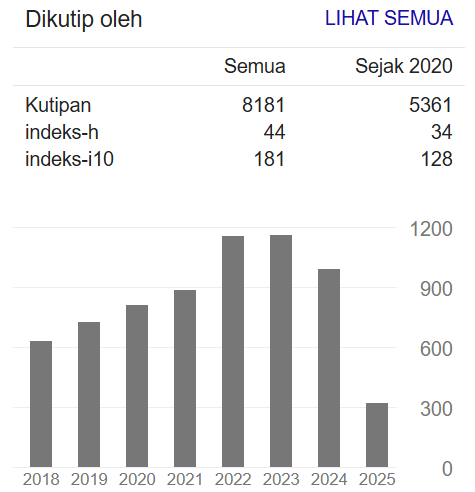DIGITAL MEDIA IN CHILD DEVELOPMENTAL SCREENING: BENEFITS AND BARRIERS (SCOPING REVIEW)
DOI:
https://doi.org/10.34011/jmp2k.v35i4.3173Keywords:
digital, media, tumbuh kembang anak, tes skriningAbstract
Gangguan perkembangan pada anak masih banyak ditemukan dan berpotensi memengaruhi prestasi mereka di masa depan. Gangguan perkembangan di Indonesia juga tinggi. Studi di Jakarta menggunakan Battelle Developmental Inventory 2 menunjukkan bahwa 28,1 % anak di bawah 3 tahun mengalami keterlambatan kognitif, dan 17,4 % mengalami keterlambatan komunikasi. Data Survei Status Gizi Indonesia (SSGI) 2024 juga melaporkan 19,8 % balita mengalami stunting, meskipun menurun dari 21,5 % pada 2023. Skrining dini menjadi langkah krusial untuk deteksi dan intervensi tepat waktu. Saat ini, media digital menghadirkan pendekatan baru yang inovatif dan mudah diakses untuk skrining tumbuh kembang anak. Penelitian ini bertujuan mengeksplorasi manfaat dan hambatan penggunaan media digital dalam skrining perkembangan anak melalui metode scoping review dengan kerangka kerja PRISMA-ScR. Literatur dicari melalui tiga basis data, PubMed, Scopus, dan ScienceDirect pada Desember 2024. Dari 1.664 artikel yang ditemukan, sepuluh artikel memenuhi kriteria inklusi: diterbitkan antara 2019–2024, berbahasa Inggris, dan membahas penggunaan media digital untuk skrining tumbuh kembang anak. Artikel berasal dari berbagai negara, seperti India, Indonesia, Australia, AS, Spanyol, Yunani, dan Inggris. Hasil studi menunjukkan bahwa media digital, seperti aplikasi dan permainan edukatif, mampu meningkatkan deteksi dini, memperkuat keterlibatan orang tua dan tenaga kesehatan. Akses luas, efisiensi waktu, dan peningkatan keterlibatan pengguna menjadi nilai tambah yang mendorong potensi adopsi teknologi ini dalam layanan kesehatan anak. Namun, hambatan seperti keterbatasan infrastruktur, literasi digital rendah, dan belum terintegrasinya sistem digital dengan layanan kesehatan masih menjadi tantangan, terutama di negara berpenghasilan rendah dan menengah. Penyesuaian teknologi dengan konteks lokal menjadi kunci untuk efektivitas maksimal dalam skrining perkembangan anak.
References
WHO, World Health Statistics 2021: monitoring health for the SDGs, sustainable development goals. 2021.
R. A. Thompson, “Development in the First Years of Life,” Futur. Child., vol. 11, no. 1, pp. 21–33, Mar. 2001, doi: 10.2307/1602807.
P. Sutapa, K. W. Pratama, M. M. Rosly, S. K. S. Ali, and M. Karakauki, “Improving Motor Skills in Early Childhood Through Goal-Oriented Play Activity,” Children, vol. 8, no. 11, pp. 1–11, 2021, doi: 10.3390/children8110994.
C. Meriem, M. Khaoula, C. Ghizlane, M. A. Asmaa, and A. O. T. Ahmed, “Early Childhood Development (0 - 6 Years Old) from Healthy to Pathologic: A Review of the Literature,” Open J. Med. Psychol., vol. 9, no. 3, pp. 100–122, 2020, doi: 10.4236/ojmp.2020.93009.
P. D. Gluckman, M. A. Hanson, C. Cyrus, and T. K. L., “Effect of In Utero and Early-Life Conditions on Adult Health and Disease,” N. Engl. J. Med., vol. 359, no. 1, pp. 61–73, Mar. 2008, doi: 10.1056/NEJMra0708473.
C. A. Boyle, P. Decouflé, and M. Yeargin-Allsopp, “Prevalence and Health Impact of Developmental Disabilities in US Children,” Pediatrics, vol. 93, no. 3, pp. 399–403, 1994, doi: https://doi.org/10.1542/peds.93.3.399.
V. Patel, D. Chisholm, T. Dua, R. Laxminarayan, and M. E. Medina-Mora, Mental, Neurological, and Substance Use Disorders, Third. Washington: International Bank for Reconstruction and Development / The World Bank, 2015. doi: 10.37573/9781585283590.005.
A. Ariani and M. Yosoprawoto, “Usia Anak dan Pendidikan Ibu sebagai Faktor Risiko Gangguan Perkembangan Anak,” J. Kedokt. Brawijaya, vol. 27, no. 2, pp. 118–121, 2013, doi: 10.21776/ub.jkb.2012.027.02.13.
World Health Organization, U. N. C. Fund, and W. B. Group, Nurturing care for early childhood development: A framework for helping children survive and thrive to transform health and human potential, vol. 37, no. 8. Geneva, 2018. [Online]. Available: https://www.who.int/teams/maternal-newborn-child-adolescent-health-and-ageing/child-health/nurturing-care
US Dept of HHS, “A COMPENDIUM OF SCREENING MEASURES FOR YOUNG CHILDREN,” no. March, 2014, [Online]. Available: https://www.acf.hhs.gov/sites/default/files/ecd/screening_compendium_march2014.pdf
P. H. Lipkin and M. M. Macias, “Promoting Optimal Development: Identifying Infants and Young Children With Developmental Disorders Through Developmental Surveillance and Screening,” Pediatr. Clin. Pract. Guidel. Policies, 21st Ed, vol. 145, no. 1, pp. 1103–1123, 2021, doi: 10.1542/9781610025034-part03-promoting.
L. Dunkel, L. Fernandez-luque, S. Loche, and M. O. Savage, “Growth Hormone & IGF Research Digital technologies to improve the precision of paediatric growth disorder diagnosis and management,” Growth Horm. IGF Res., vol. 59, p. 101408, 2021, doi: 10.1016/j.ghir.2021.101408.
J. K. Swift and B. E. Wampold, “Inclusion and Exclusion Strategies for Conducting Meta-Analyses,” Psychother. Res., vol. 28, no. 3, pp. 256–266, 2018.
E. Aromataris and Z. Munn, JBI Manual for Evidence Synthesis. JBI, 2020.
T. Thaventhiran et al., “A Digital Health Solution for Child Growth Monitoring at Home: Testing the Accuracy of a Novel ‘GrowthMonitor’ Smartphone Application to Detect Abnormal Height and Body Mass Indices,” Mayo Clin. Proc. Digit. Heal., vol. 1, no. 4, pp. 498–509, 2023, doi: https://doi.org/10.1016/j.mcpdig.2023.08.001.
A. Serrano-Barroso, J. P. Vargas, E. Diaz, I. M. Gómez-González, G. Ruiz, and J. C. López, “A Videogame as a Tool for Clinical Screening of Possible Vulnerability to Impulsivity and Attention Disturbances in Children,” Children, vol. 9, no. 11, 2022, doi: 10.3390/children9111652.
N. Deveau et al., “Intelligence-Based Medicine Machine learning models using mobile game play accurately classify children with autism,” Intell. Med., vol. 6, no. March, p. 100057, 2022, doi: 10.1016/j.ibmed.2022.100057.
E. I. Toki, V. Zakopoulou, G. Tatsis, and J. Pange, “Automated Detection of Neurodevelopmental Disorders Using Face-to-Face Mobile Technology Among Typically Developing Greek Children: Randomized Controlled Trial.,” JMIR Form. Res., vol. 8, p. e53465, Oct. 2024, doi: 10.2196/53465.
K. R. Barr et al., “Family member and service provider experiences and perspectives of a digital surveillance and service navigation approach in multicultural context: a qualitative study in identifying the barriers and enablers to Watch Me Grow-Electronic (WMG-E) program wi,” BMC Health Serv. Res., vol. 24, no. 1, p. 978, 2024, doi: 10.1186/s12913-024-11397-y.
S. Bhavnani et al., “The association of a novel digital tool for assessment of early childhood cognitive development, ‘DEvelopmental assessment on an E-Platform (DEEP)’, with growth in rural India: A proof of concept study,” eClinicalMedicine, vol. 37, p. 100964, 2021, doi: https://doi.org/10.1016/j.eclinm.2021.100964.
I. Dubey et al., “Using mobile health technology to assess childhood autism in low-resource community settings in India: An innovation to address the detection gap,” Autism, vol. 28, no. 3, pp. 755–769, 2024, doi: 10.1177/13623613231182801.
Hasriani, A. U. Salmah, A. I. Moedjiono, H. Hidayanty, and A. Mallongi, “Analysis of Knowledge and Skills of Cadres in Early Detection of Stunting Toddler Development in Soppeng Regency, Indonesia,” Pharmacogn. J., vol. 15, no. 5, pp. 833–838, 2023, doi: 10.5530/pj.2023.15.159.
D. P. Hutabarat, W. Wijaya, and W. D. Wijaya, “Internet of things-based digital scale to detect stunting symptoms in babies under two years of age,” Int. J. Electr. Comput. Eng., vol. 14, no. 3, pp. 3467–3474, 2024, doi: 10.11591/ijece.v14i3.pp3467-3474.
M. Melinda, F. Arnia, A. Yafi, N. A. C. Andryani, and I. K. A. Enriko, “Design and Implementation of Mobile Application for CNN-Based EEG Identification of Autism Spectrum Disorder,” Int. J. Adv. Sci. Eng. Inf. Technol., vol. 14, no. 1, pp. 57–64, 2024, doi: 10.18517/ijaseit.14.1.19676.
Y. K. Dwivedi et al., “Setting the future of digital and social media marketing research: Perspectives and research propositions,” Int. J. Inf. Manage., vol. 59, no. July 2020, p. 102168, 2021, doi: 10.1016/j.ijinfomgt.2020.102168.
Johnson Oyeniyi, “The role of AI and mobile apps in patient-centric healthcare delivery,” World J. Adv. Res. Rev., vol. 22, no. 1, pp. 1897–1907, 2024, doi: 10.30574/wjarr.2024.22.1.1331.
M. Vargas-santiago, D. A. León-velasco, and C. E. Maldonado-sifuentes, “A State-of-the-Art Review of Artificial Intelligence ( AI ) Applications in Healthcare : Advances in Diabetes , Cancer , Epidemiology , and Mortality Prediction,” pp. 1–37, 2025.
T. Thaventhiran et al., “A Digital Health Solution for Child Growth Monitoring at Home: Testing the Accuracy of a Novel ‘GrowthMonitor’ Smartphone Application to Detect Abnormal Height and Body Mass Indices,” Mayo Clin. Proc. Digit. Heal., vol. 1, no. 4, pp. 498–509, 2023, doi: 10.1016/j.mcpdig.2023.08.001.
R. Gallardo Vergara and M. Monserrat Gallardo, “Serious Games para mejorar la atención en niños y niñas con trastorno por déficit de atención e hiperactividad (TDAH): un estudio piloto.,” Acta Colomb. Psicol., vol. 26, no. 2, pp. 33–49, 2023, [Online]. Available: https://actacolombianapsicologia.ucatolica.edu.co/article/view/4072
V. Eapen et al., “‘Watch Me Grow- Electronic (WMG-E)’ surveillance approach to identify and address child development, parental mental health, and psychosocial needs: study protocol,” BMC Health Serv. Res., vol. 21, no. 1, 2021, doi: 10.1186/s12913-021-07243-0.
S. Bhavnani et al., “Development, feasibility and acceptability of a gamified cognitive DEvelopmental assessment on an E-Platform (DEEP) in rural Indian pre-schoolers–a pilot study,” Glob. Health Action, vol. 12, no. 1, 2019, doi: 10.1080/16549716.2018.1548005.
D. Mukherjee et al., “Proof of Concept of a Gamified DEvelopmental Assessment on an E-Platform (DEEP) Tool to Measure Cognitive Development in Rural Indian Preschool Children,” Front. Psychol., vol. 11, 2020, doi: 10.3389/fpsyg.2020.01202.
A. H. Al Rahmad et al., “Effectiveness of Using Android-Based Applications for Nutrition Monitoring of Toddlers in Banda Aceh,” Open Access Maced. J. Med. Sci., vol. 10, no. E, pp. 444–451, 2022, doi: 10.3889/oamjms.2022.7599.
K. A. Boulton, M. Hilton, E. Sutton, and A. J. Guastella, “Apps and Digital Resources for Child Neurodevelopment, Mental Health, and Well-Being: Review, Evaluation, and Reflection on Current Resources,” J. Med. Internet Res., vol. 27, pp. 1–14, 2025, doi: 10.2196/58693.
J. James, “Confronting the scarcity of digital skills among the poor in developing countries,” Dev. Policy Rev., vol. 39, no. 2, pp. 324–339, 2021, doi: 10.1111/dpr.12479.
H. M. Lestari, A. V. Miranda, and A. Fuady, “Barriers to telemedicine adoption among rural communities in developing countries: A systematic review and proposed framework,” Clin. Epidemiol. Glob. Heal., vol. 28, no. June, p. 101684, 2024, doi: 10.1016/j.cegh.2024.101684.
I. J. Borges do Nascimento et al., “Barriers and facilitators to utilizing digital health technologies by healthcare professionals,” npj Digit. Med., vol. 6, no. 1, pp. 1–28, 2023, doi: 10.1038/s41746-023-00899-4.
Downloads
Published
How to Cite
Issue
Section
Citation Check
License
Copyright (c) 2025 Hayu Retno Paramesti, Cahya Tri Purnami, Martha Irene Kartasurya

This work is licensed under a Creative Commons Attribution-ShareAlike 4.0 International License.




